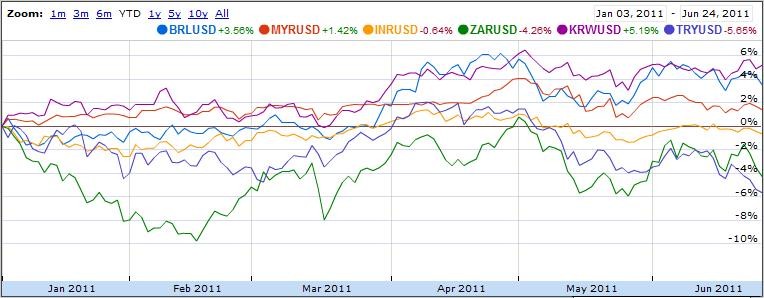How to Find Value in the Emerging Markets Equity Exodus
Post on: 7 Май, 2015 No Comment

Share | Subscribe
Emerging market equity ETFs posted another selloff for the month of January, totaling $10 billion in outflows globally — the largest monthly outflows for this segment on record. In fact, last week marked the 6 th week of steady outflows, and set a record as the largest weekly outflow since August 2010. Investors seeking to avoid exposure to country specific turmoil, weak Chinese manufacturing data, plus interest rate adjustments in emerging market countries like Turkey, drove the selloff.
Despite strong negative sentiment and ongoing scrutiny of the Fed’s potential next steps, emerging market equity valuations are attractive and the asset class remains a vital part of a well-diversified portfolio (emerging markets currently account for 11% of the world’s market capitalization). As Russ Koesterich recently pointed out. emerging market equities are generally growing at a faster rate than developed markets and now look cheap by most metrics. Currently emerging market equities are trading at about a 40% discount to developed country stocks, representing the largest discount since the financial crisis. There is significant value here if you know where to look.
The Emerging Market Equity ETF Landscape
It’s important to consider the bigger picture when contemplating the significance of these outflows. We believe we are far from an emerging markets equities crisis, as we are down only 8% this year. Emerging market ETFs represent about $229 billion of the $4.5 trillion total investable emerging market equity universe. That’s about 5%, and is also less than a quarter of the assets held by active emerging market funds.  Additionally, the $35 billion drop in emerging market ETF assets since the end of May 2013 represents less than 0.8% of the underlying market.
While emerging market ETFs as a category have experienced outflows recently, this has not been the case for all funds. In fact, the majority of outflows have occurred in the two largest emerging market equities funds (Vanguard’s FTSE Emerging Markets ETF ( VWO ) and the iShares MSCI Emerging Markets ETF ( EEM )). Many others, including the iShares Core MSCI Emerging Markets ETF ( IEMG ) and the iShares MSCI Brazil capped ETF ( EWZ ), actually saw significant inflows in January despite a challenging macro environment.
It’s also important to note that ETFs aren’t the only investment vehicles experiencing outflows for emerging market exposures. Mutual funds have had outflows of $34.2 billion since the start of June 2013 through last month, while ETFs outflows totaled $16.4 billion during the same period.  For the month of January, mutual fund outflows totaled $3.4 billion while, as previously mentioned, ETF outflows totaled $10 billion.
We know that emerging markets tend to be volatile, and we expect them to remain so in the near term. As Russ Koesterich notes in a recent post. not all emerging markets are created equal. Bright spots, such as South Korea, have strong economic fundamentals. What’s more, emerging markets can provide significant returns over time when implementing the appropriate strategy. Investors can increase their emerging market equity exposure through liquid and transparent ETFs at the regional, sub-regional, or individual country level.  It pays to look under the hood of your emerging market equity investments as we explored in Emerging Equity Exposed last year.
Longer term, we believe growth prospects for emerging markets remain attractive relative to the developed world. Here are three ways to add emerging markets to your long-term investment strategy:
1.   Diversify across several emerging market countries and increase your core exposure to large, mid and small cap stocks. Today, perhaps more than ever before, investors are drawn to the high degree of diversification available through ETFs, which can mitigate the risk and volatility of individual countries, sectors, and companies. One way to do this is through the iShares Core MSCI Emerging Markets ETF ( IEMG ).
2.   Customize by country. If you are seeking exposure to individual regions with strong fundamentals, we have two suggestions:
a.   China. We are currently overweight China. We believe Chinese equities are undervalued considering their growth and profitability potential and suggest the iShares MSCI China ETF ( MCHI ).
b.   South Korea. We are currently overweight South Korea, recently upgrading it from neutral due to its stocks’ attractive valuations and exposure to global growth. We like the iShares MSCI South Korea Capped ETF ( EWY ).
3.   Minimize volatility. In the current interest rate environment, short and mid-term volatility can be a major concern. Consider the iShares MSCI EM Minimum Volatility ETF ( EEMV ) for downside protection plus exposure to potential gains in the emerging market equities space.
Investors may also want to look at exposure to frontier markets. such as the iShares MSCI Frontier 100 ETF ( FM ). This segment of the market has seen meaningful gains — roughly 18% — in the past year.
International investing involves risks, including risks related to foreign currency, limited liquidity, less government regulation and the possibility of substantial volatility due to adverse political, economic or other developments. These risks often are heightened for investments in emerging/ developing markets, in concentrations of single countries or smaller capital markets. Frontier markets involve heightened risks related to the same factors and may be subject to a greater risk of loss than investments in more developed and emerging markets.
The iShares Minimum Volatility ETFs may experience more than minimum volatility as there is no guarantee that the underlying index’s strategy of seeking to lower volatility will be successful. Information on VWO is provided strictly for illustrative purposes and should not be deemed an offer to sell or a solicitation of an offer to buy shares of any securities other than the iShares Funds, that are described in this material.
iS-11664
20Blog%20%7C%20Global%20Market%20Intelligence&el=How%20to%20Find%20Value%20in%20the%20Emerging%20Markets%20Equity%20Exodus /%














